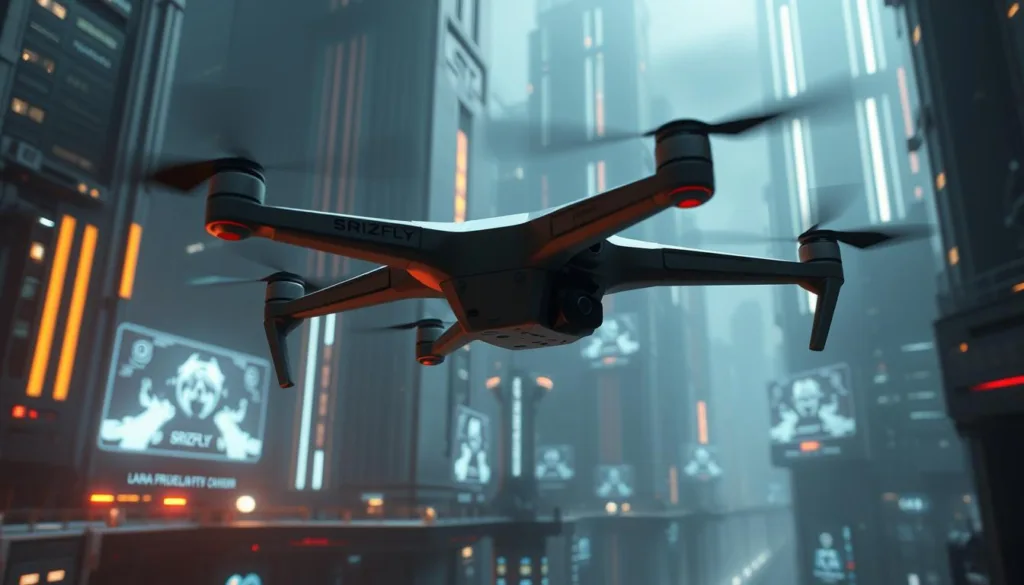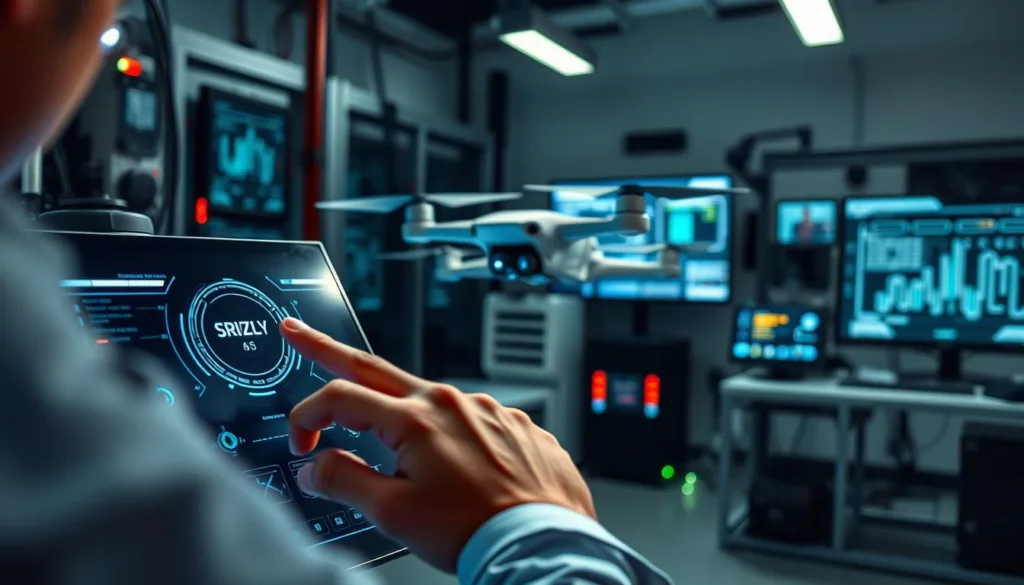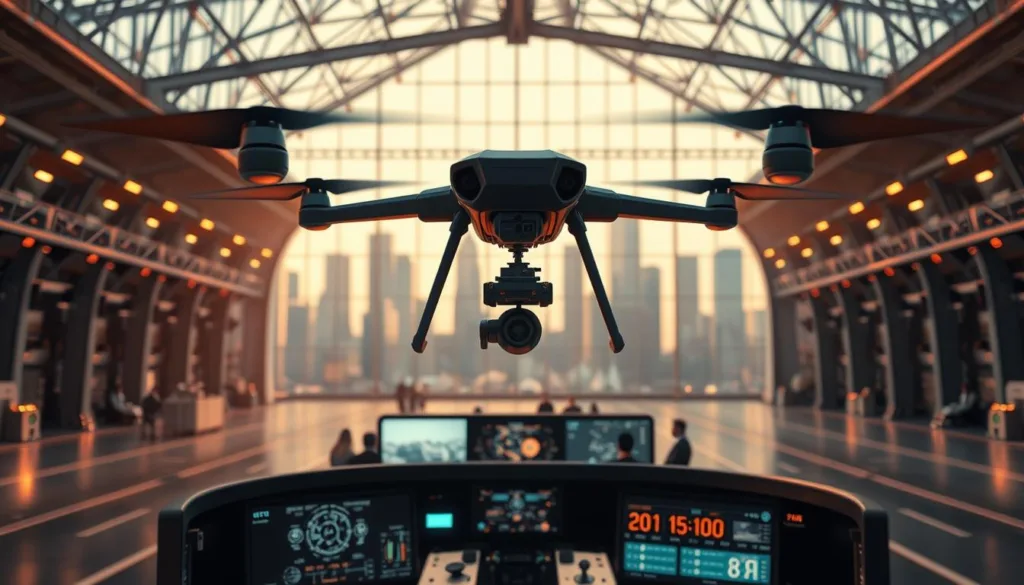SRIZFLY brings enterprise-grade mission scenarios to one practical platform. We design realistic training for inspection, public safety, agriculture, surveying, aerial photography, refinery checks, and emergency response.
Our platform uses an advanced unreal engine foundation to deliver fidelity, reliability, and scalability. This matters: high-fidelity physics and visuals translate to faster skills growth and safer operations in the real world.
We compare community tools like AirSim and commercial projects to show where SRIZFLY fits. You’ll see verified reviews and pricing context — plus practical workflows from hardware checks to mission tuning.
Start simply: takeoff and hover, then advance to inspection corridors and emergency drills. Try our 10-day risk-free evaluation to validate training KPIs and measure real outcomes.
Key Takeaways
- SRIZFLY offers enterprise and educational training across many mission types.
- Advanced engine tech improves realism, reliability, and measurable skills growth.
- We align features—VR, camera workflows, configurable environments—to mission value.
- Context from AirSim and market reviews helps you evaluate options with confidence.
- Start with a hands-on path and try a 10-day risk-free evaluation to prove impact.
What Makes Unreal Engine Ideal for Drone Simulation Today
Precise physics and world-scale maps let teams rehearse missions before they fly in the real world. That combination matters: it turns virtual practice into measurable skill gains and safer outcomes.
Cinematic visuals and accurate motion models create believable scenarios. High-fidelity materials, lighting, and large environments let users train in urban grids, refineries, transmission corridors, and farms.
Open research tools have also accelerated progress. AirSim—an Unreal plugin—offers SITL and HIL support with PX4 and ArduPilot. It exposes APIs in C++, Python, C#, and Java, plus a Computer Vision mode and weather controls.
- Realism: cinematic graphics and precise physics reduce transfer gap to field ops.
- Extensibility: plugins, blueprints, and C++ pipelines speed development.
- Research-ready: open APIs and SITL/HIL workflows support validation and autonomy testing.
With Microsoft moving AirSim toward Project AirSim, the ecosystem is becoming more commercial and safety-focused. We apply these capabilities in SRIZFLY to give teams a repeatable, scalable training platform and a clear path from manual learning to autonomy.
SRIZFLY Drone Simulator at a Glance: Enterprise Power, Educational Ease
SRIZFLY combines enterprise rigor with classroom simplicity to give teams a single, scalable training path.
We built a wide mission portfolio so your program aligns with real work. Choose training for powerline inspection, refinery walkthroughs, mapping routes, public safety search grids, agriculture, and firefighting.
Our professional workflows speed deployment: requirements capture, software design, system development, and project implementation get you from pilot idea to operational training fast.
Education-first lessons make learning repeatable and safe. New pilots practice procedures and build skills without risk while instructors track progress and outcomes.
Immersive options include VR support, multi-camera pipelines, and customizable scenes. Built on unreal engine, optimizations keep sessions smooth across labs and classrooms.
We provide clear documentation, onboarding, and responsive support. Options like custom scenes and data export let you tailor features to goals. The result: faster pilot progress, measurable skills growth, and stronger ROI.
unreal engine drone simulator
High-fidelity visuals and precise flight math let teams rehearse missions that match real operational demands.
We leverage the engine’s graphics and physics stacks to model line-of-sight, sensor occlusion, and approach angles. This makes each training run realistic and measurable.
Responsive settings let you tune weather, control sensitivity, and camera composition for each lesson. Instructors can set difficulty, change lighting, or alter wind to test real-world choices.
FPV options and scene customization ensure your training maps to actual sites. Asset pipelines bring site models into the simulation so trainees practice on accurate layouts.

| Capability | Benefit | Typical Use |
|---|---|---|
| Graphics & Physics | Realistic sensor behavior | Inspection corridors, approach angles |
| Custom Settings | Repeatable test conditions | Lesson tuning, performance checks |
| FPV & Scene Import | Site-specific practice | Class labs and enterprise rehearsals |
Result: an experience that feels immediate and practical—precise enough for inspections and flexible enough for classrooms. We help you standardize best practices across teams.
Getting Started: Hardware, Install, and First Launch
We recommend a simple, repeatable setup so your team can focus on learning and skills, not troubleshooting.
System checklist
Start with a practical system checklist: a modern Intel Core-class CPU, a dedicated graphics card (GTX 1060-class or better), 16GB+ RAM, and fast storage. Aim for at least 30GB free for projects and assets.
Verify card drivers and Windows updates before you begin. Confirm controller support on each workstation to prevent last-minute problems.
Installing Unreal Engine via Epic Games Launcher
Download the Epic Games Launcher, sign in, and install the latest version of the Unreal Engine. Keep the engine and GPU drivers updated for stability.
Create a first project template and test driver compatibility before loading complex scenes. This reduces common issues and shortens time-to-first-flight.
Controller setup and input calibration
Connect your controller and run calibration so throttle, yaw, pitch, and roll track precisely. Accurate control is the fastest way to build confidence and skills.
In engine settings, balance visual quality and frame rate—prioritize smooth input over ultra graphics. Map buttons for arming, flight modes, camera switching, and failsafe to standardize training across users.
- Use our quick-start profiles to reduce setup issues.
- Document symptoms early if you see problems; support resources speed resolution.
- Build a repeatable first-launch checklist—consistency is the best way to scale training.
Core Features That Elevate Training and Safety
High-fidelity flight behavior and monitoring tools turn practice runs into measurable skill gains.
We model flight behavior with tuned physics and interaction models so pilots feel realistic lift, drag, inertia, and contact dynamics.
Camera and view control
Camera pipelines include FPV, chase, and multi-view layouts. Instructors switch views to review maneuvers and coach students more effectively.
APIs and research tools
We integrate APIs and tools so teams can test autonomous systems, run repeatable simulations, and export training data.
- Support for SITL/HIL workflows and common APIs (C++, Python, C#, Java) mirrors research practices.
- Weather controls, CV modes, and ROS2 wrappers help validate autonomy and collect labeled datasets.
- Control profiles standardize inputs across cohorts—reducing variability and improving outcomes.
Result: capabilities that map to inspection accuracy, mapping repeatability, and emergency rehearsal—so trainees build control skills in a safe, supported environment.
Mission Scenarios in SRIZFLY for Enterprise Operations
Our scenarios focus on repeatability so crews gain consistent, measurable skills. We map tasks to real checklists and operational goals. This helps teams close the gap between practice and field performance.
Electric power and refinery inspection
Powerline missions simulate tower approaches, standoff rules, and waypoint compliance using repeatable routes and checklists. Refinery runs train pilots on confined spaces, line-of-sight breaks, and hazard awareness within complex environment geometry.
Public safety and emergency response
Public safety drills cover perimeter sweeps, thermal camera checks, and coordinated comms for search-and-rescue and firefighting. These scenarios test decision-making under pressure and clear SOP-aligned workflows.
Agriculture, surveying, and aerial photography
Agriculture scenarios enforce consistent altitude, overlap, and speed for mapping. Surveying runs emphasize ground control points, flight line planning, and QA passes before capture. Aerial photography modules teach framing, exposure, and smooth motion control so instructors can review pilot inputs and footage.
Additional capabilities: fpv drone practice for tight interior flights, controller and control profiles that match SOPs, and adaptable weather, lighting, and regional environment settings. This mission range accelerates readiness and standardizes outcomes across distributed teams. Try a focused mission set to train the way you work.
How SRIZFLY Compares: AirSim and Community Simulators
Not all simulators serve the same mission—match your toolset to the outcomes you need.
SRIZFLY targets enterprise training. We focus on VR immersion, scene customization, instructor workflows, and mission libraries built on an unreal engine foundation.
Our platform streamlines onboarding, assessment, data export, and continued support. That makes scaling across labs and crews easier and measurable.
Microsoft AirSim
AirSim is an open-source research project with APIs and SITL/HIL for PX4 and ArduPilot. It remains a benchmark for autonomy testing and validation.
Microsoft is archiving the original release and moving toward Project AirSim — a commercial path that emphasizes safety and end-to-end autonomous systems validation.
Uncrashed FPV
Uncrashed is a low-cost game-style option ($14.99 on Steam) with very positive reviews and an editor for custom tracks.
It excels for FPV practice: multiplayer modes, broad controller support, and accessible worlds help users build raw piloting skill quickly.
“Choose tools by goals: inspection accuracy, autonomy research, or FPV skill ramp.”
- SRIZFLY: enterprise features, mission standardization, and instructor tools.
- AirSim: research APIs, SITL/HIL, and autonomy prototyping.
- Uncrashed: affordable practice, editor, and strong player reviews.
We help users select the right mix: SRIZFLY for mission-critical work, community tools for prototyping and extra practice. Check GPU card and driver settings to keep sessions smooth across platforms.
Ready to decide? Try our 10-day trial to validate training KPIs and compare outcomes directly.
A Beginner’s Training Path: From Basics to Advanced Maneuvers
Begin with a clear, structured path so new pilots build confidence quickly. A stepwise plan reduces errors and speeds skill gains. We focus on repeatable exercises and measurable goals to make learning efficient and safe.
Foundations: takeoff, hover, orientation, and safe landings
Start with fundamentals: arming, throttle curves, stable takeoff, hover holds, and confident landings. Small, repeated drills create muscle memory.
Early wins—smooth hover and clean landings—reinforce good habits and cut training time.
Progression: precise control, obstacle workflows, and scenario-based simulations
Move to precise control tasks: box patterns, figure eights, and altitude holds before introducing obstacle workflows. Add corridor tracking and point-of-interest orbits to mirror field tasks.
FPV drone sessions strengthen depth perception and proximity control in a safe setting. Use structured flight goals and rubrics so pilots and instructors can track progress and target practice time.
- Troubleshoot early issues: fix overcorrection, drift, or slow inputs with sensitivity and expo changes.
- Use recording tools from the unreal engine to review runs and annotate coaching points.
- Increase difficulty gradually: crosswinds, tighter gates, and complex routes build resilient flight skills.
- Finish with mission rehearsals that validate readiness for your organization’s standard operations.
Troubleshooting and Optimization for Smooth Simulation
Smooth sessions start with targeted tuning—graphics, drivers, and controller mapping matter most. We focus on fast, repeatable fixes so training stays productive.
Performance tuning: tune graphics settings to keep frame rate steady and prioritize input response for reliable flight evaluations. Update GPU drivers and check your card control panel. Turning off MFAA or disabling FreeSync has resolved stutters and visual problems for many users.
Control issues: map inputs carefully and recalibrate your controller. Set endpoints, dead zones, and curves so controls feel consistent. Many problems disappear after a quick calibration pass.
Visual artifacts and stability: test on a stable unreal engine version before upgrading classroom machines. Use engine options like fixed frame rates for assessment runs. Validate intel core CPU power settings and disable disruptive Windows game mode features.
- Confirm system thermals—thermal throttling mimics software faults.
- Document issues with logs and reproducible steps for faster support.
- Keep a known-good profile for quick rollback in labs.
- After fixes, re-run a standard route to confirm gains.

What’s Next: The Future of Unreal-Based Drone Simulation
The landscape for aerial research and autonomy is moving from open projects to supported commercial releases. Microsoft will archive the original AirSim and focus on Microsoft Project AirSim as a packaged project for end-to-end autonomy.
Why that matters: Project AirSim promises formal code review, safety testing, and enterprise support. Existing research features — APIs, SITL/HIL, CV mode, and weather controls — remain foundational while production tools are added.
Expect practical gains: synthetic-data pipelines, automated testing, and compliance checks that fit enterprise workflows. FPV camera and goggle pipelines will grow more nuanced for training realism.
Emerging capabilities to watch
- Tighter links between autonomous systems, vehicles, and edge inference.
- Mixed-fleet scenarios that blend multivehicle rehearsals and data fusion.
- Packaged tools for data governance, LMS integration, and program-level support.
| Trend | What it Enables | Enterprise Impact |
|---|---|---|
| Project commercialization | Code review, safety pipelines | Faster certification and trust |
| Synthetic data & automated tests | Scalable training datasets | Better AI validation and metrics |
| Mixed-fleet simulations | Cross-vehicle rehearsals | Operational cohesion and efficiency |
SRIZFLY will integrate these capabilities so your teams adopt AI-assisted flight without disrupting current instruction. Your programs gain measurable safety benefits, repeatable validations, and ongoing support as the world of simulations matures.
Conclusion
SRIZFLY closes the gap between classroom drills and on-site missions. Our mission library spans basic training, powerline and refinery inspection, public safety, agriculture, surveying, aerial photography, and emergency response. This range shows our strengths in software design, system development, and project delivery.
Teams gain rapid experience and practical skills through structured simulations that match the way you work. We pair high-fidelity unreal engine visuals with mission-focused features so practice converts to safer field results.
We listen to users, track reviews and community advances, and deliver responsive support. If you have GPU card limits or run into problems, our guides and team shorten time-to-fix and keep programs moving.
FPV and fpv drone options, camera workflows, and assessment tools make this a complete solution for classroom and enterprise use. Ready to validate outcomes? Start a 10-day risk-free trial and see the difference.
FAQ
What is SRIZFLY’s Unreal Engine drone simulator designed for?
SRIZFLY delivers an enterprise-grade training platform for inspection, public safety, agriculture, logistics, and education. We combine high-fidelity physics, immersive visuals, and scalable lesson plans so teams and schools can train pilots and test autonomous systems without risk.
Why use an Unreal-based platform for simulation?
Unreal-based technology offers world-scale environments, accurate physics, and photoreal visuals. That realism improves transfer of skills to real hardware and supports research workflows for autonomy, sensor validation, and mission rehearsal.
What mission types does SRIZFLY support out of the box?
The platform includes ready scenarios for tower and pipeline inspection, refinery and electric-power checks, public-safety drills, firefighting exercises, agricultural surveys, mapping missions, and aerial photography training.
What hardware do I need to run SRIZFLY effectively?
We recommend an Intel Core-class CPU, a dedicated graphics card with up-to-date drivers, 16GB+ RAM, and SSD storage. These specs ensure smooth frame rates for VR, multi-camera feeds, and complex scenes.
Does SRIZFLY support FPV and VR training modes?
Yes. The product offers FPV camera views, first- and third-person perspectives, multi-view camera tools, and VR support for immersive pilot training and mission rehearsal.
Can I test autonomous systems and integrate APIs?
Absolutely. SRIZFLY includes APIs and developer tools to run SITL/HIL-style workflows, validate autonomy algorithms, and log sensor data for research and certification projects.
How does SRIZFLY compare to Microsoft AirSim and community simulators?
SRIZFLY focuses on enterprise features—scene customization, VR workflows, and support—while AirSim targets research with rich APIs for autonomy. Community projects may offer low-cost access and multiplayer features; SRIZFLY emphasizes reliability, scalability, and training outcomes.
Is there a free trial or demo available?
We offer a 10-day free trial so teams and training centers can evaluate functionality, workflows, and compatibility risk-free before committing to deployment.
How do I set up controllers and calibrate inputs?
SRIZFLY provides a device wizard for controller mapping, sensitivity adjustment, and dead-zone calibration. Follow the on-screen steps, test with a practice mission, and tweak axis curves for precise control.
What optimization steps improve performance?
Update GPU drivers, lower post-processing and shadow detail, enable appropriate anti-aliasing settings, and use SSDs for scene streaming. We also supply recommended presets tailored to common workstation classes.
What common control issues should I expect and how are they resolved?
Typical issues include incorrect axis mapping, stale drivers, or conflicting USB devices. Resolve problems by re-running the calibration wizard, updating firmware and drivers, and isolating controllers during setup.
Can SRIZFLY be used in classroom and certification programs?
Yes. The platform supports scalable student management, curriculum modules, assessment tools, and reporting to help training centers and universities deliver standardized lessons and track progress.
Does SRIZFLY support multi-aircraft or multiplayer scenarios?
SRIZFLY enables multi-vehicle scenarios for coordinated missions and can run multiplayer sessions for team drills, allowing trainees to practice communication and deconfliction in realistic contexts.
How do I import custom environments or vehicle models?
We provide tools and documentation for importing 3D assets, textures, and vehicle dynamics. Our support team assists with scene optimization and ensuring models match physical parameters for accurate flight behavior.
What support options are available for enterprise customers?
SRIZFLY offers tiered support including onboarding, technical integration, priority troubleshooting, and bespoke scene or mission development to meet operational needs.
How does SRIZFLY help reduce training time and costs?
By offering repeatable, measurable scenarios and realistic failure modes, the platform speeds up skill acquisition. Case studies show improved training efficiency and lower operational risk compared with field-only instruction.
Are there known visual artifacts and how can I fix them?
Visual artifacts often stem from driver settings, anti-aliasing, or monitor features. We recommend updating drivers, testing alternative anti-aliasing (e.g., disabling MFAA), and using supplied graphics presets to eliminate artifacts.
Can the simulator log flight data for post-mission analysis?
Yes. SRIZFLY logs telemetry, video, and sensor data. Instructors and engineers can review flights, generate reports, and export datasets for research or compliance records.
What future capabilities are planned for SRIZFLY?
We are expanding AI-assisted training, deeper autonomy testing tools, improved FPV workflows, and tighter integration with enterprise IT systems to support large-scale deployments and research projects.
How do I start a trial or request a demo for my organization?
Contact our sales team through the SRIZFLY website to activate the 10-day free trial, schedule a live demo, or discuss customization and licensing for enterprise or educational deployments.



